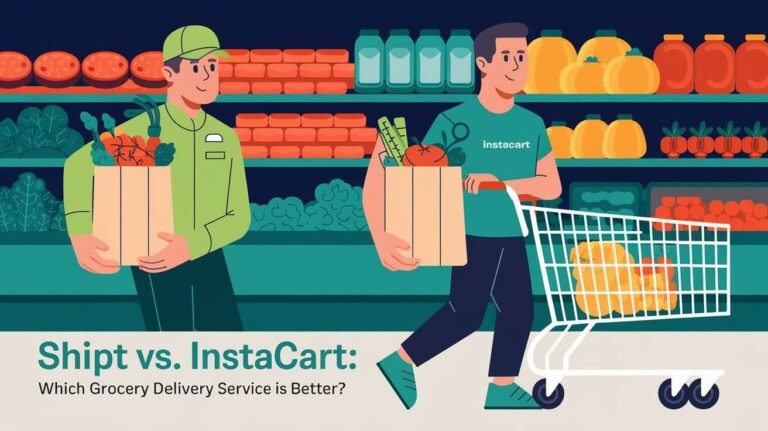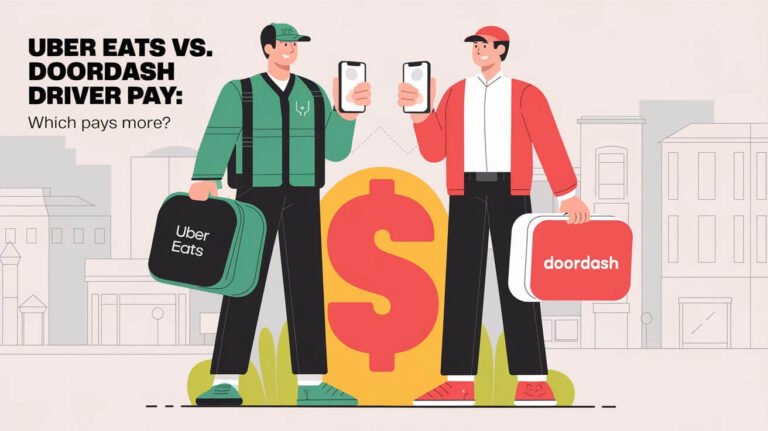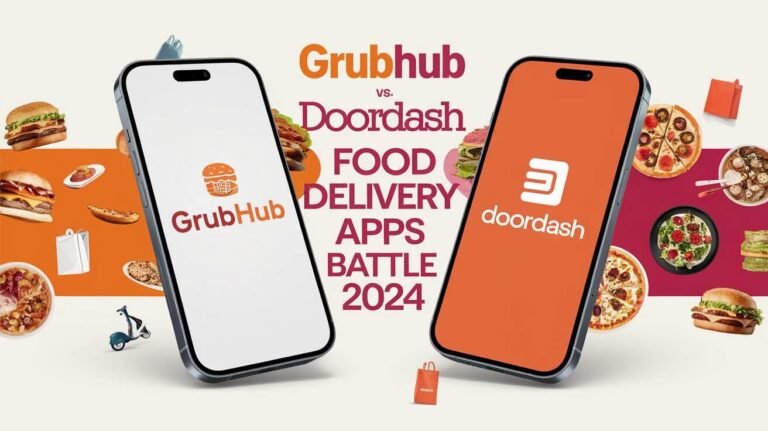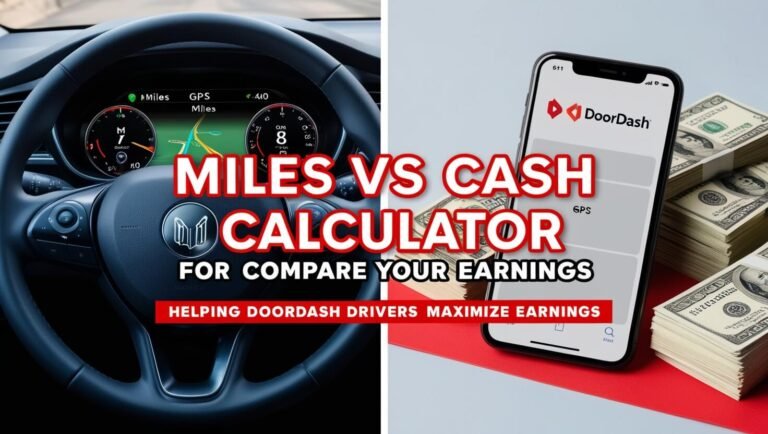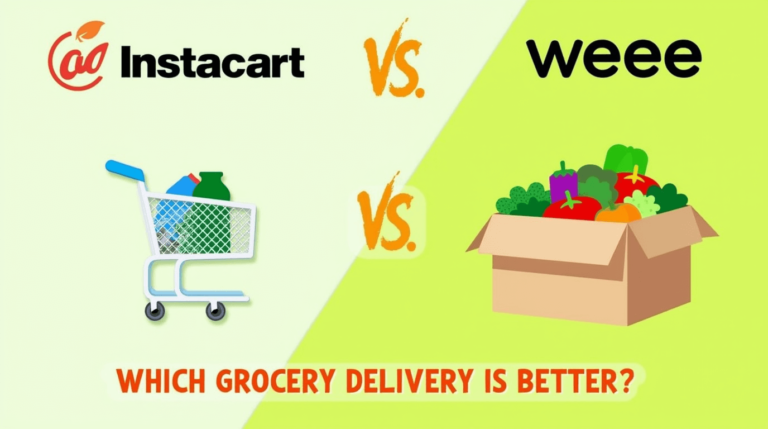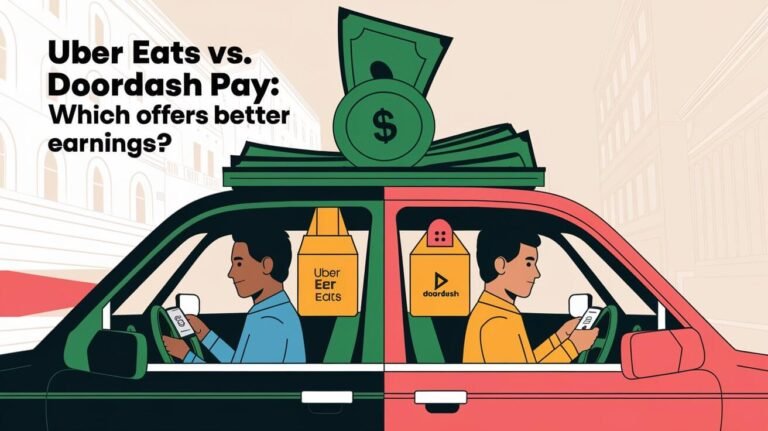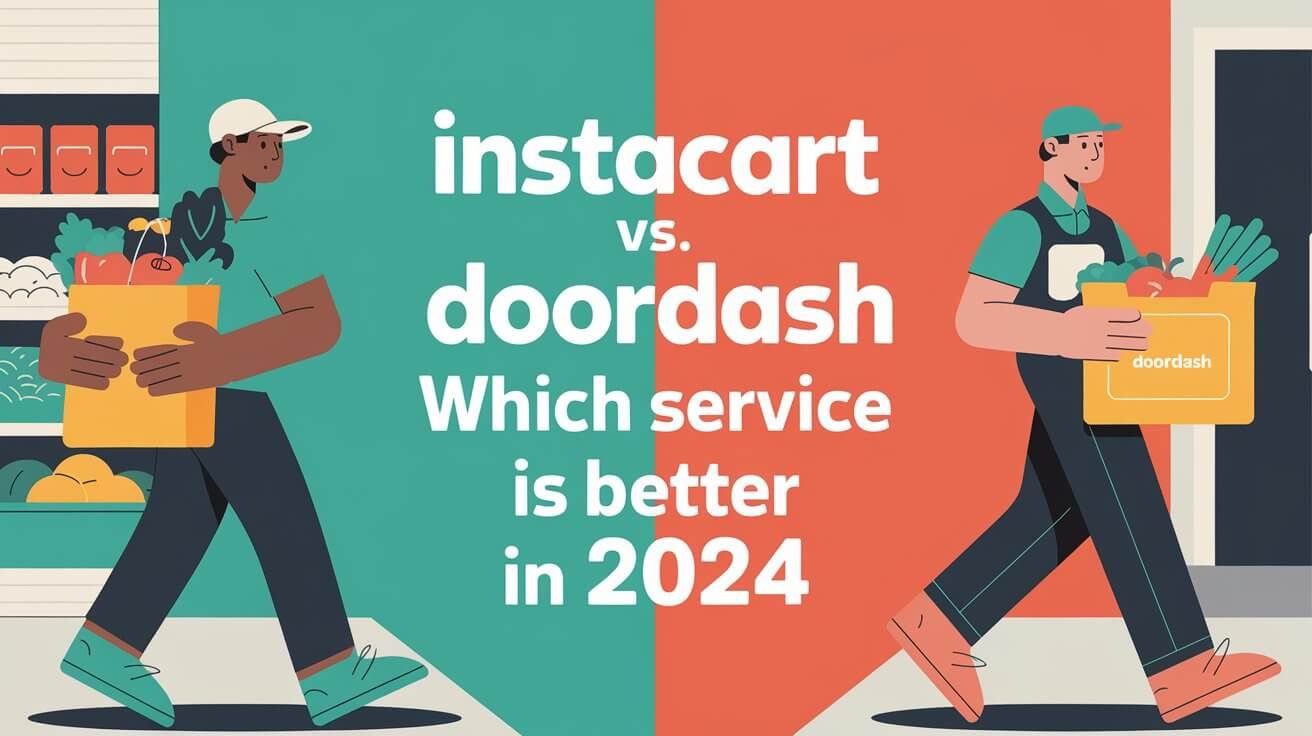
In the fast-changing world of grocery and food delivery, Instacart and Doordash stand out. They are key players in the on-demand delivery market. Knowing the differences between them is important for both users and workers.
From where they operate to how much drivers make, we’ll cover it all. This detailed comparison will guide you through the world of grocery and food delivery in 2024.
Platform Overview and Market Presence
Instacart and DoorDash have led the online delivery world for years. They serve many areas in North America, meeting the needs of delivery drivers, customer experience, and online shopping fans.
North American Coverage and Availability
Instacart works in over 5,500 cities in the U.S. and Canada. It focuses on delivering groceries and essentials. DoorDash also covers over 5,500 cities, mainly delivering food from restaurants, with some grocery items too.
Service Types and Specializations
Instacart is a top name in grocery delivery, working with big names like Aldi and Walmart. DoorDash, on the other hand, is a big player in restaurant food delivery. It has more than 50% of the North American meal delivery market.
Market Share Statistics
The combined value of Uber, DoorDash, and Instacart is over $200 billion. This shows the huge investment and growth in online delivery. But, their performance varies. Uber’s stock has grown 9% yearly since its IPO. DoorDash’s stock has only gone up 11% since December 2020, down 40% from its first day.
| Company | Market Cap | Profitability | Market Share |
|---|---|---|---|
| Uber | $150 billion | Operating loss of $579 million in 2023 | 23% of observed U.S. meal delivery sales in March 2024 |
| DoorDash | $47 billion | Operating loss of $579 million in 2023 | 67% of observed U.S. meal delivery sales in March 2024 |
| Instacart | $10 billion | Net loss of over $2 billion in 2023 | Declining market share, facing competition |
Service Model Differences
When comparing instacart vs doordash, their main service models are quite different. Instacart shoppers handle the whole grocery shopping and delivery. They can choose between full-service or in-store shopping. DoorDash drivers, on the other hand, focus on picking up food from restaurants and delivering it to customers.
Instacart orders usually take longer because shoppers have to go through grocery stores. But, they can earn more, between $7 and $26 per hour. DoorDash, with its quicker deliveries, might offer more consistent pay for drivers. Their base pay is between $2 and $10 per order.
| Feature | Instacart | DoorDash |
|---|---|---|
| Fulfillment Process | Full-service shoppers handle the entire grocery shopping and delivery | Drivers mainly pick up and deliver pre-prepared meals from restaurants |
| Order Completion Time | Longer, as shoppers must navigate grocery stores and select each item | Faster, as drivers simply pick up and deliver pre-prepared meals |
| Average Earnings | $7 to $26 per hour for full-service shoppers | $2 to $10 per order, with potential for more consistent hourly earnings |
| Vehicle Requirements | Technically requires a car for shopping, but some flexibility exists | Allows various transportation methods, including bikes, making it more cost-effective for some delivery workers |
| Work Environment | More indoor time for shopping tasks | More time outdoors traveling between restaurants and customers |
| Delivery Areas | Suited for suburban areas with easier parking and lighter traffic | Better suited for urban areas with higher density |
The differences between instacart vs doordash service models greatly affect the delivery experience, earnings, and work environment. Knowing these differences helps delivery drivers choose the best option for them in the delivery services comparison.
Driver Pay Structure and Earnings
In the gig economy, how much a delivery driver makes is key when picking between Instacart and DoorDash. Both offer good pay, but they differ in base pay, tips, and bonuses.
Base Pay Components
Instacart’s full-service shoppers earn between $15-$20 an hour on average. Their pay depends on the batch size, how far they have to go, and how hard the items are. DoorDash’s base pay is around $16-$18 an hour, with extra from promotions and tips.
Tips and Bonus Systems
Drivers for both Instacart and DoorDash get to keep all their tips. Instacart’s pay can be boosted by customer tips, which are usually 5-20% of the order. DoorDash has a “Time Earnings Mode” that adds a flat hourly rate to their regular pay.
Average Hourly Earnings
Recent surveys show Instacart shoppers in New York City make about $15.58 an hour. DoorDash Dashers in the same area earn at least $29.93 an hour. DoorDash seems to pay more, which is good for drivers in big cities like New York.
| Delivery Service | Average Hourly Earnings |
|---|---|
| Instacart | $15 – $20 |
| DoorDash | $16 – $18 |
| Amazon Flex | $19 – $25 |
| Uber Eats | $20 |
| Postmates | $18 |
| Shipt | $20 |
| Favor | $10 – $20 |
| GoPuff | $14 |
| Grubhub | $14 – $42 |
| Caviar | $16 – $25 |
The gig economy offers flexible earnings for delivery drivers. Knowing how each platform pays can help drivers choose the best service for their needs and goals.
Vehicle Requirements and Delivery Methods
Instacart and DoorDash have different ways of handling delivery vehicles. Instacart needs drivers to have a car for big orders. DoorDash, on the other hand, lets drivers use cars, bikes, or scooters. This can save money for drivers in some places.
Both services require drivers to have valid licenses and insurance. Instacart’s shoppers can choose their hours, working as independent contractors. DoorDash Dashers also have flexible hours but can earn more with higher acceptance rates.
| Feature | Instacart | DoorDash |
|---|---|---|
| Delivery Vehicle Options | Car | Car, Bike, Scooter |
| Average Delivery Time per Worker | N/A | 4 hours |
| Order Volume | Decent, in high-demand areas | High, largest food delivery in the U.S. |
| Training for New Workers | None | 5-7 business days |
Choosing between Instacart and DoorDash depends on your needs. Both offer benefits and drawbacks for delivery vehicle options and transportation for gig work. It’s all about what you prefer as a delivery driver.
Instacart Vs Doordash: Order Types and Volumes
Instacart and DoorDash have different roles in the food delivery world. Instacart focuses on grocery and retail, making shopping and delivery easy for customers. DoorDash is known for restaurant delivery but also delivers groceries and more.
Peak Hours and Demand Patterns
DoorDash gets more orders all day long. Instacart’s busy times match when people usually shop for groceries. This shows how different people’s needs are for food and grocery delivery.
Order Size Comparisons
Instacart orders are bigger because people buy more groceries at once. DoorDash orders are smaller and more frequent, meeting the quick needs of restaurant customers.
| Metric | Instacart | DoorDash |
|---|---|---|
| Order Volume Growth (Q2 2023 YoY) | -2% | 25% |
| Gross Order Value (Q2 2023 YoY) | 3% | 26% |
| Revenue Growth (Q2 2023 YoY) | 15% | 33% |
| Profitability | Profitable since Q2 2022 | Net loss decreased from $263M in Q2 2022 to $172M in Q2 2023 |
The data shows Instacart and DoorDash have different trends. Instacart’s order volume is down a bit, but DoorDash’s is way up. This shows the big demand for food delivery and grocery delivery today.
Driver App Features and User Experience
Instacart and DoorDash are leading the way in delivery app technology. They’ve created powerful driver apps for their independent contractors. These apps make it easier for drivers to fulfill orders and improve their experience.
Instacart’s app helps drivers find items in stores and manage shopping lists. DoorDash’s app alerts drivers about busy areas, helping them earn more. This shows how both apps aim to support their drivers.
Both apps also make it easy for drivers to talk to customers and support teams. Drivers can accept orders, get directions, and track their earnings. This ensures a smooth delivery experience.
These apps are key to keeping gig workers happy. Instacart’s app has a 4.8 rating on the App Store, and DoorDash’s has a 4.7. This shows drivers are generally very satisfied.
As the market gets more competitive, Instacart, DoorDash, and others will keep improving their apps. They aim to make life better for gig workers, who are crucial to their success.
Payment Systems and Cashout Options
In the gig economy, fast payment systems are key for workers like Instacart shoppers and DoorDash drivers. Instacart and DoorDash both send out payments weekly. They usually process these by Wednesday for the week before.
But, they differ in how quickly you can get your money. Instacart and DoorDash have different ways to cash out fast.
Instant Payment Features
Instacart started Instant Cashout in 2019. It lets shoppers get their earnings right after they finish deliveries. You can cash out your earnings from a full batch in just two hours.
You need to have done at least five deliveries and have a balance of $5. But, there’s a $0.50 fee for this service.
DoorDash has a similar feature called Fast Pay, which costs $1.99 per cashout. But, DoorDash drivers can also use DasherDirect for free instant payments.
These fast payment options help gig workers get their money quickly. They meet the needs of the gig economy payments world.
Direct Deposit Schedules
Instacart and DoorDash both send out payments weekly. Instacart usually sends these by Wednesday for work done from Monday to Sunday. DoorDash has a similar schedule.
The instant cashout options and direct deposit schedules help gig workers manage their money. They can get their wages when they need them most.
Background Check and Signup Process
In the gig economy, job requirements and delivery driver onboarding differ by platform. Instacart and DoorDash have their own rules for new delivery drivers.
To start, you must be at least 18 years old (21 for alcohol deliveries) and have a valid driver’s license. Instacart asks you to lift up to 50 pounds. DoorDash is more flexible with vehicle requirements.
The background check is a key part of joining. DoorDash checks your driving and criminal history, looking for things like speeding tickets or DUIs. They also check for violent crimes or serious offenses.
DoorDash is more open to hiring people with felonies, looking at each case individually. Uber Eats and Postmates, on the other hand, often don’t hire people with felonies.
Signing up for Instacart and DoorDash is easy, done mostly through their apps. You’ll need to give personal details and agree to the background check.
Even though rules vary, the main goal is the same. It’s to keep everyone safe and make sure deliveries are reliable.
Delivery Area Flexibility and Scheduling
The gig economy brings a lot of flexibility to Instacart and DoorDash drivers. Instacart lets its drivers work on-demand. They can choose when to accept orders without scheduling ahead of time. This gives Instacart drivers full control over their work hours.
DoorDash, on the other hand, has a scheduling feature. It lets Dashers pick the best times for more money. Even though DoorDash doesn’t need set shifts, this feature helps Dashers plan for busy times. Both platforms use a zone system for delivery areas. Busier zones often mean more money for drivers.
The flexibility of flexible gig work and on-demand delivery jobs attracts many. Whether it’s Instacart’s open schedule or DoorDash’s scheduled shifts, these services meet the needs of those who value work-life balance and income control.

